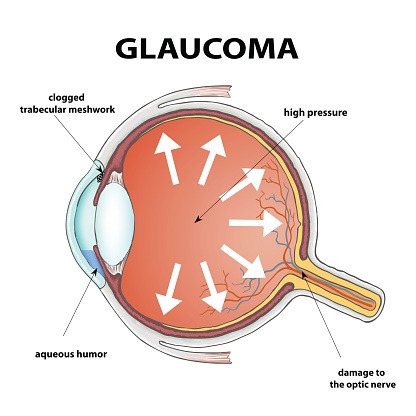Glaucoma
 Glaucoma is a leading cause of blindness in the United States. It is a disease characterized by damage to the optic nerve (the cable which connects the eye to the brain). This results in vision loss. While high eye pressure is a factor which increases the risk and progression of glaucoma, the pressure goal is highly individualized. The biggest barrier to treating glaucoma is awareness that one has it or is at risk for it. This is because glaucoma can progress for many years without obvious symptoms. Unfortunately, damage caused by glaucoma is permanent, so early identification and intervention is essential. There are multiple risk factors for glaucoma including age, ethnicity, family history, and diabetes.
Glaucoma is a leading cause of blindness in the United States. It is a disease characterized by damage to the optic nerve (the cable which connects the eye to the brain). This results in vision loss. While high eye pressure is a factor which increases the risk and progression of glaucoma, the pressure goal is highly individualized. The biggest barrier to treating glaucoma is awareness that one has it or is at risk for it. This is because glaucoma can progress for many years without obvious symptoms. Unfortunately, damage caused by glaucoma is permanent, so early identification and intervention is essential. There are multiple risk factors for glaucoma including age, ethnicity, family history, and diabetes.
Glaucoma screening involves a comprehensive eye exam including a vision screen, eye pressure check, dilated exam, and sometimes a visual field test and OCT image of the optic nerves.
Some patients will be identified as “Glaucoma Suspects” or patients at risk for developing glaucoma. These patients will be monitored at set intervals to readily identify if or when the disease process begins to occur.
Once diagnosed, glaucoma can be treated in several ways including prescription eye drops, oral medications, laser procedures, and sometimes surgical intervention. The effect of treatment is monitored with scheduled exams and testing modalities.
Glaucoma treatment is highly individualized. If a surgical procedure is considered, the best option for each specific patient will be recommended. Several of our surgeons offer MIGS (Minimally Invasive Glaucoma Surgery) procedures. These are newer, less invasive forms of glaucoma surgery. Not all glaucoma can be treated with MIGS procedures. Some may require more involved surgical interventions. Our practice offers the services of sub-specialist Rachel Niknam, MD, who is fellowship-trained at the prestigious University of Pennsylvania Scheie Eye Institute in techniques to manage even the most severe forms of glaucoma.
